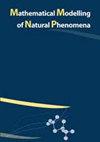年龄结构对慢性髓系白血病肿瘤免疫模型稳定性的影响
IF 2.1
4区 数学
Q2 MATHEMATICAL & COMPUTATIONAL BIOLOGY
引用次数: 0
摘要
本文提出并分析了慢性髓性白血病(CML)的肿瘤免疫反应模型。它是在前人研究的常微分方程模型(ODE)的基础上建立的。描述了骨髓细胞的增殖、分化以及白血病细胞和免疫细胞的相互作用。该模型基于非单调免疫反应。在低水平时,免疫反应随着肿瘤负荷的增加而增加,而在高水平时,肿瘤抑制免疫系统的作用(免疫抑制)。我们认为细胞的年龄是由一个连续变量来描述的,我们用它来构造系统并得到一个偏微分方程模型(PDEs)。我们分析了模型平衡点的稳定性,并将其与年龄被描述为离散状态的情况进行了比较。特别是,描述由免疫系统控制引起的缓解的平衡点在PDE模型的某些情况下是不稳定的,而在ODE的情况下,它是系统稳定的。本文章由计算机程序翻译,如有差异,请以英文原文为准。
Influence of the age structure on the stability in a tumor-immune model for chronic myeloid leukemia
In this paper a model of tumor-immune response for chronic myeloid leukemia (CML) is proposed and analyzed. It is based on the ordinary differential equations' models (ODE) studied in former works. The proliferation of cells, their differentiation in the bone marrow and the interactions of leukemic and immune cells are described. The model is based on a non-monotonic immune response. At low levels immune response increases with the tumor load, whereas at high levels tumor is suppressing the effect of the immune system (immunosuppression). We consider that the age of cells is described by a continuous variable which we use to structure the system and obtain a partial differential equations' model (PDEs). We analyze the stability of the equilibrium points of the model and compare it to the case where age was described as a discrete state. In particular, an equilibrium point describing remission, induced by a control of the immune system, is shown to be unstable in certain situations for the PDE model, whereas in the ODE case, it was systematically stable.
求助全文
通过发布文献求助,成功后即可免费获取论文全文。
去求助
来源期刊

Mathematical Modelling of Natural Phenomena
MATHEMATICAL & COMPUTATIONAL BIOLOGY-MATHEMATICS, INTERDISCIPLINARY APPLICATIONS
CiteScore
5.20
自引率
0.00%
发文量
46
审稿时长
6-12 weeks
期刊介绍:
The Mathematical Modelling of Natural Phenomena (MMNP) is an international research journal, which publishes top-level original and review papers, short communications and proceedings on mathematical modelling in biology, medicine, chemistry, physics, and other areas. The scope of the journal is devoted to mathematical modelling with sufficiently advanced model, and the works studying mainly the existence and stability of stationary points of ODE systems are not considered. The scope of the journal also includes applied mathematics and mathematical analysis in the context of its applications to the real world problems. The journal is essentially functioning on the basis of topical issues representing active areas of research. Each topical issue has its own editorial board. The authors are invited to submit papers to the announced issues or to suggest new issues.
Journal publishes research articles and reviews within the whole field of mathematical modelling, and it will continue to provide information on the latest trends and developments in this ever-expanding subject.
 求助内容:
求助内容: 应助结果提醒方式:
应助结果提醒方式:


